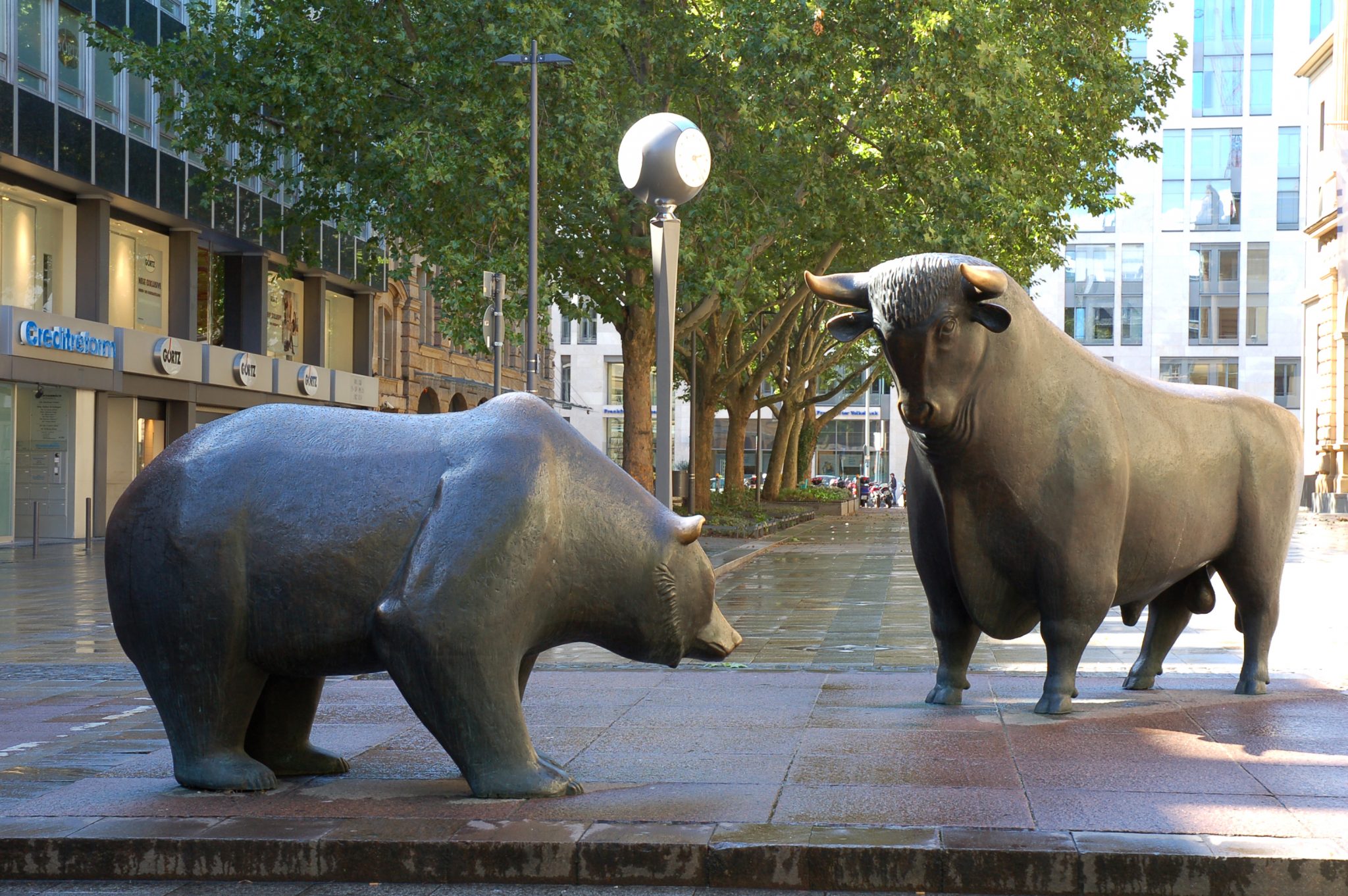
My Prediction on the Economy & Market
I have been wrestling for months now about one question: inflation or deflation?
The other night, while chatting with a friend, it all finally came together for me. Epiphanies don’t come around very often, but when they do, boy, does it feel good!
I have been following the likes of Peter Schiff (gold bug), Jim Rogers (agriculture bug) and others since my return to the States in 2007. I knew that something was seriously wrong with our economy then, just as I do now. Everywhere I turned, it seemed as though every well-proven prognosticator seemed to be on the side of inflation, due to the combination of the Fed running its printing presses 24/7 and our massive government and personal debt. However, during the crisis at the end of 2007 and beginning of 2008, all investment classes fell precipitously, save for one– cash.
I understand that the demand for cash occurred prior to the stimulus package and was in the midst of the bank bailout package enacted by Congress, which created a huge influx on capital to the market– all inflationary events. But while I understood that inflation will be present in the future, based on simple economics (supply/demand), however, I also couldn’t stop asking myself, “why would 2007 not repeat itself during the next crisis?”
So I kept reading, researching and asking myself the same question over and over again, “inflation or deflation?”
Then I read “Conquer the Crash: You Can Survive and Prosper in a Deflationary Depression” by Robert Prechter. It is the only book that I have read or heard of, which states that deflation, not inflation, will be the problem of the future. After tearing through 400+ pages in less than three days, I let the question percolate– “inflation or deflation?”
Then, finally, after months of thought, the answer hit me while I was explaining “Conquer the Crash” to a friend of mine. He asked me what I thought was in store for the economy in the months and years ahead. After regurgitating what I had been reading and hearing, he asked me again, “yeah, but what do you think?”

I present you with my thesis below– exactly as I told my friend– on what I expect to happen in the economy and investment community in the months and years ahead.
Before we delve right in, however, let’s first take a look at the facts of the past:
At the end of 2006/beginning of 2007,
– The massive bubble in the housing market climaxed.
– Commodities reached all-time highs during this same period.
– Stocks reached all-time highs as well.
Then the housing market collapsed, essentially, overnight.
– Reason?
– Crisis in confidence in the hyper-inflated mortgage market.
Along with the housing market, the prices of everything else fell along with it, including precious metals, save one investment.
– U.S. Treasuries, T-bills and currency
Why?
– People were scared. They also had massive credit bills (mortgage, credit cards, loans) to pay– only currency can pay off debt.
In return,
– The U.S. dollar became extremely expensive. So much so, in fact, that Warren Buffett stated in Berkshire Hathaway’s annual report in 2008 that the “U.S. Treasury bond bubble of late 2008” might go down as an extraordinary event in financial history, just like the Internet bubble of the 1990s and housing bubbles of the 2000s.
Thesis:
The U.S. dollar is about to get much much more expensive. Then, it will become very, very cheap.
Unfortunately for Mr. Buffett, whose Berkshire Hathaway earlier this year made the largest acquisition in the firm’s history with the purchase of what is widely considered to be the best-run railroad company in the U.S., Burlington Northern, and for the hoards of the gold and commodity bugs, all goods are about to get much, much cheaper than they were in March 2008, which was the market low during this latest crisis.
“But the government has been printing currency like crazy, there’s no way that’ll happen– inflation is imminent!,” you say.
I agree. The government is printing a lot of currency; however, it is creating much more credit than currency… and there is a BIG difference between the two.
Time for a classroom lesson:
Grab some caffeine, it’s about to get boring… BUT I can virtually guarantee you that 99% of the people in the U.S. do not know what you’re about to learn. Fortunately for you, it’s information that will open your eyes to a brand new world, one that will allow you to understand just how significant the problems in the U.S. (and world) are and just how significant they will be in the coming months and years ahead. Sadly, this is information that no one in the media discusses or is anything that you will learn in college– maybe not even in graduate school– let alone high school. But it is information that literally affects all of us each and every day and, therefore, is information that we should grow up knowing and learning about.
Before we start, please allow me to make one distinction clear. In today’s society, we tend to use the words money and currency interchangeably. However, there is a HUGE difference between the two.
Money is something that holds value, which can be exchanged for goods. Throughout history, only gold and silver have been continuously recognized as money. There have been times throughout history where other goods, such as salt, have also been considered money, but only gold and silver have remained constant.
Currency is a medium of exchange that one can use in order to purchase something that has value. It is derived from the word current and, therefore, must remain in movement in order to be valuable. The U.S. dollar is a currency because there is nothing valuable about a piece of paper standing on its own– it’s just a piece of paper. The U.S. dollar is valuable because it is backed by the full faith and credit of the United States. However, if U.S. dollars were to lose favor due to debasing its currency, for instance, it would become worth less and, if it were printed relentlessly by the U.S. Treasury, then it might become worth close to nothing at all. Currency must be spent in order to be valuable.
Now, let’s start with some history…
Throughout history, only two items have consistently been accepted as money– gold and silver. Gold and silver have always been rare metals, while other items, such as salt, have gone from once rare and in high demand (for its ability to store meat) to simple commonplace. However, gold is so rare that if you stacked up all of the gold that has ever been discovered, it would not fill two Olympic-size swimming pools. And although silver is not nearly as rare as gold, and, therefore, holds much less value, it is considered to be one of the best conduits of energy and, therefore, is used in nearly all electronics. While gold and silver have consistently held monetary value throughout time, both have been endured the treatment of being the forgotten children of civilization as well.
Generally speaking, whenever civilizations have found themselves in precarious situations, became greedy, or just plain manipulative, almost, without fail, they have found a way around the gold (and silver) standard. Straying from the gold and silver standard has come by using less of it in coinage, as the Romans did, or by creating currency valued in gold and then debasing it by allowing the gold standard to disappear completely, as we have now with the U.S. dollar and other currencies. Typically, this debasing has usually occurred toward the end of a civilization, mainly, from a civilization overextending itself militarily or by accumulating massive amounts of debt.
The U.S. dollar, except in a few instances, has always been backed in some fashion by gold and/or silver. Those instances were during the Civil War, during a short period from 1777-1788 and during the War of 1812. The gold standard in the U.S. was later breached in 1971 under President Nixon and has remained as such, making it the longest period of time that our nation has not adhered to the the historical standard, but more on that later.
Let’s first talk about the Federal Reserve system…
The current Federal Reserve system was created under the Federal Reserve Act of 1913 by largely a Democrat partisan vote. The act created a private, decentralized system that was intended to put the monetary system outside the reach of Wall St. The Republicans favored a centralized bank, much like that of the European system, which would have kept the government in control of the system and, in turn, would have allowed Wall St and the financial industry to impact the country’s monetary policy through lobbying and/or bribery, etc.
A not so well-known fact, however, is that Senator Nelson Aldrich, who was largely in charge of regulating the banking industry, was the person most responsible for the creation of the Federal Reserve system. Aldrich, whose daughter was married to John D. Rockefeller, Jr and was close friends with J.P. Morgan, created the framing for the Federal Reserve system at a secret meeting with some of the most powerful and influential financiers, who represented 25% of the world’s wealth at the time, at a resort on Jekyll Island, GA in 1910. The Aldrich Plan was intended to create a central bank, which Aldrich himself had originally opposed prior to studying the European banking system. The plan was so reviled in Congress when it was introduced that it took three years to pass.
With the passing of the Federal Reserve Act of 1913, however, occurred one of the greatest transfers of wealth in world history. The reason? The fractional reserve baking system.
Fractional reserve banking is the banking practice by which banks are only required to keep a fraction of their deposits on reserve, currently about 10%, and are allowed to loan out the remaining amount. By loaning out their deposits, however, banks are, in fact, creating additional money supply that would not otherwise be in the marketplace, known as the money multiplier and, thus, the transfer of wealth begins.
An example of the money multiplier effect is as follows:
You deposit $100 into the bank. The bank is required by the Federal Reserve to maintain a minimum reserve of 10% of deposits. Therefore, the bank can lend out the other 90% of your initial deposit, which creates a maximum increase in the money supply of $900 from your original deposit.
A problem with this system, however, is that since only a fraction of a bank’s deposits are required to be on reserve, if many people wish to withdraw their money from the bank simultaneously, also known as a “run on the bank,” the bank might have a very difficult time coming up with all of the money requested. During the Great Depression runs caused many banks to fail and, in turn, many people to lose all of the money that they had in the bank. As a result, the government created the Federal Deposit Insurance Corporation (FDIC), which guarantees individual deposits up to a specified amount– currently $250,000 per individual account. The FDIC is able to guarantee this money by charging each bank a small fee to participate in the insurance program.
Another piece of information that is hardly discussed is that typically a bank has the right to call one’s outstanding mortgage at any time. While this tactic is atypical, it is one that many banks can should it need to come up with currency quickly, such as in the case of a run on the bank.
Before we continue, let me add a little known fact about the relationship between the U.S. Treasury and the Federal Reserve…
It is a little known fact that the U.S. Treasury must borrow money from the Federal Reserve, in the form of U.S. Treasuries, in order to print more money. Therefore, the U.S. Treasury cannot mathematically ever repay its debt to the Federal Reserve, at least in the form of U.S. dollars.
For a full history on the how the Federal Reserve was created and why, please check out “The Creature from Jekyll Island” by Edward Griffin. Griffin also gave a speech some years ago in Los Angeles that encapsulates the events and book in about an hour.
Grab another cup, the history lesson is now continuing…
Let’s fast-forward a few years now to 1944. It was in that year that world leaders met at the United Nations Monetary and Financial Conference for three weeks in Bretton Woods, New Hampshire to discuss the world’s monetary system. It was during this meeting that the allied nations agreed on the U.S. dollar as the world’s reserve currency under the stipulation that it always be backed by gold.
As stated in my article “Seek Refuge in Modern Day Communism”:
“The world understood that inflation was the enemy of any economy, having seen the extraordinary hyperinflation created by the Weimar Republic of Germany, where the money supply grew so rapidly that bills printed just a week prior were deemed worthless.
However, after enduring some of the complexities that maintaining a currency to a fixed price of gold created– such as other countries’ reserves growing more quickly than the United States’, and the U.S.’s choice to pay for the Vietnam War and The Great Society programs through inflation and not increased tax revenues– the gold standard officially ended in 1971, when the U.S. closed the gold window, thus making the dollar and gold nonconvertible.”
Before we go any further, however, let me state something that many people might not remember:
In 1933 the government, under Executive Order 6102 during the Roosevelt administration, banned the ownership of gold– except U.S. gold eagle coins, which were legal tender– and fixed the price of U.S. dollars to gold at $35/oz. The executive order remained intact, even after President Nixon announced in 1971 that U.S. dollars would no longer be convertible into gold. The limitation on gold by U.S. citizens was repealed on December 31, 1974 under the Ford administration but by that time, the value of gold in the world market had soared in value to $186.50 on the London exchange, meaning the U.S. dollar had lost over 80% of its value during a 51-year time span on the global market.
Demand for gold over the next six years skyrocketed as U.S. citizens devoured supplies of gold, in hopes of protecting their already lost fortunes. Gold on January 21, 1980, the day after President Reagan was sworn into office, reached $850/oz– a 450% increase in six years time on the world market and a whopping 2,400% increase from the U.S. fixed rate during the same time period.
Let us remember this lesson– the U.S. government can change the rules at any time and will do so in order to preserve itself, regardless of how much damage it inflicts on its citizens.
In the coming weeks I plan to continue our history lesson, as well as give further insight into my investment thesis over the coming months and years. I will attempt to expedite my writing, as it appears that my thesis might just be on an expedited path, given the recent strength in the U.S. dollar due to the crisis in Greece and the heightened anxiety in Europe, as well as the anticipation that China is overheating. Until then, I suggest staying as liquid as possible.
More to come soon!
C.J.










